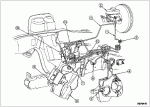islandhopper03
New member
Howdy everyone!!
Finished up my newbie post last week and need to get into the nitty gritty of our new to us, 1996 XLT. Its sure is a pretty truck and I am excited about working on it and getting it back into tip top condition. She's gotta a lot of wear and tear with almost 245,000 miles on the 351 (Windsor? Cleveland?) but for now, she runs and drives. There is a good bit of rust underneath and very little on the exterior. We bought it from used car salesman friend of ours sight unseen as this particular model (actually the Eddie Bauer edition) is my wife's favorite vehicle. I promised to make sure it runs and drives good for her and in driving it now for the past few weeks, I've got a loud "clunk" in the rear end when accelerating from a complete stop, either forward or in reverse. Took it to a mechanic friend of mine and he firmly believes that the pinion bearing and rear differential at the very least need replacing. Since I am new to this, I pulled the tag off of the rear pumpkin and deduced that I have the standard Ford 8.8 rear end with the 3.55 limited slip differential. Pic of the tag is attached. I've gone and sold my daily driver truck to buy what parts I need to get this first issue resolved so I am needing to get it done pretty quick. The motorcycle gets cold this time of year in northern Virginia. So my thoughts and questions on the repair thus far are:
1. Being a newbie, how do I know if I have ABS?
2. I'd like to replace the whole rear axle and switch to disc brakes. I've found these on the old interwebs and wonder if they would work for my application:
http://www.lowmileageparts.com/1996-FORD-BRONCO-Rear-Axle-Assembly-P128584.aspx?gclid=Cj0KEQiAn9-kBRDloNeUw7Pe_YwBEiQA4HXMU8FUeHn04ylqM2Im0s0BEtCRqeXs4SpLkGgWE8AGh6QaAkDb8P8HAQ#.VJhqEF4CA
3. I'm currently running 32 inch BFGoodrich tires. Will the new 8.8 rear end be ok for this setup? Should I switch to something more heavy duty?
4. If i do switch out the whole rear axle assembly, what concerns about brakes and sensors should I address?
5. If the whole rear axle assembly doesn't happen, what specifically should I buy to replace everything inside the rear differential? Would this work?
http://shop.broncograveyard.com/88-Rear-End-Rebuild-Kit/productinfo/32380B/
6. Could I or should I change the gearing?
Thanks in advance,
Roy





Finished up my newbie post last week and need to get into the nitty gritty of our new to us, 1996 XLT. Its sure is a pretty truck and I am excited about working on it and getting it back into tip top condition. She's gotta a lot of wear and tear with almost 245,000 miles on the 351 (Windsor? Cleveland?) but for now, she runs and drives. There is a good bit of rust underneath and very little on the exterior. We bought it from used car salesman friend of ours sight unseen as this particular model (actually the Eddie Bauer edition) is my wife's favorite vehicle. I promised to make sure it runs and drives good for her and in driving it now for the past few weeks, I've got a loud "clunk" in the rear end when accelerating from a complete stop, either forward or in reverse. Took it to a mechanic friend of mine and he firmly believes that the pinion bearing and rear differential at the very least need replacing. Since I am new to this, I pulled the tag off of the rear pumpkin and deduced that I have the standard Ford 8.8 rear end with the 3.55 limited slip differential. Pic of the tag is attached. I've gone and sold my daily driver truck to buy what parts I need to get this first issue resolved so I am needing to get it done pretty quick. The motorcycle gets cold this time of year in northern Virginia. So my thoughts and questions on the repair thus far are:
1. Being a newbie, how do I know if I have ABS?
2. I'd like to replace the whole rear axle and switch to disc brakes. I've found these on the old interwebs and wonder if they would work for my application:
http://www.lowmileageparts.com/1996-FORD-BRONCO-Rear-Axle-Assembly-P128584.aspx?gclid=Cj0KEQiAn9-kBRDloNeUw7Pe_YwBEiQA4HXMU8FUeHn04ylqM2Im0s0BEtCRqeXs4SpLkGgWE8AGh6QaAkDb8P8HAQ#.VJhqEF4CA
3. I'm currently running 32 inch BFGoodrich tires. Will the new 8.8 rear end be ok for this setup? Should I switch to something more heavy duty?
4. If i do switch out the whole rear axle assembly, what concerns about brakes and sensors should I address?
5. If the whole rear axle assembly doesn't happen, what specifically should I buy to replace everything inside the rear differential? Would this work?
http://shop.broncograveyard.com/88-Rear-End-Rebuild-Kit/productinfo/32380B/
6. Could I or should I change the gearing?
Thanks in advance,
Roy





Last edited by a moderator:

